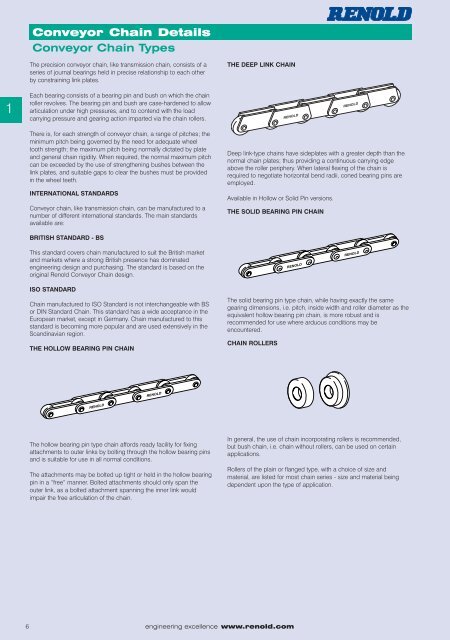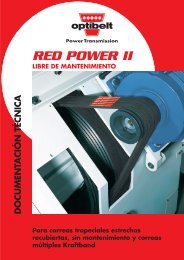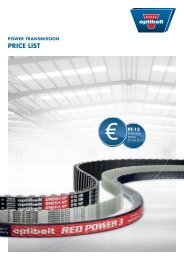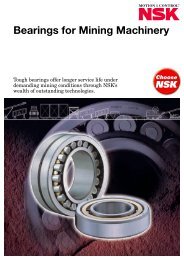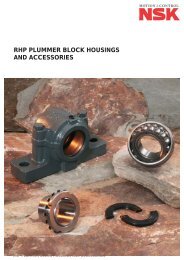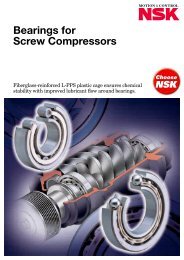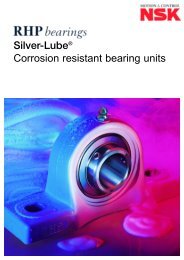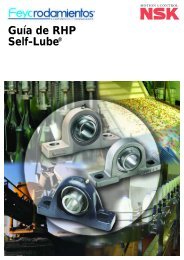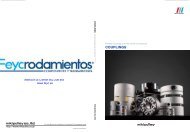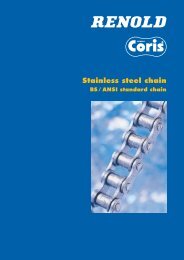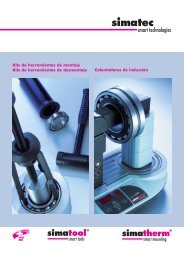Conveyor chain catalogue - sections 1&2
Conveyor chain catalogue - sections 1&2
Conveyor chain catalogue - sections 1&2
Create successful ePaper yourself
Turn your PDF publications into a flip-book with our unique Google optimized e-Paper software.
<strong>Conveyor</strong> Chain Details<br />
<strong>Conveyor</strong> Chain Types<br />
The precision conveyor <strong>chain</strong>, like transmission <strong>chain</strong>, consists of a<br />
series of journal bearings held in precise relationship to each other<br />
by constraining link plates.<br />
THE DEEP LINK CHAIN<br />
1<br />
Each bearing consists of a bearing pin and bush on which the <strong>chain</strong><br />
roller revolves. The bearing pin and bush are case-hardened to allow<br />
articulation under high pressures, and to contend with the load<br />
carrying pressure and gearing action imparted via the <strong>chain</strong> rollers.<br />
There is, for each strength of conveyor <strong>chain</strong>, a range of pitches; the<br />
minimum pitch being governed by the need for adequate wheel<br />
tooth strength; the maximum pitch being normally dictated by plate<br />
and general <strong>chain</strong> rigidity. When required, the normal maximum pitch<br />
can be exceeded by the use of strengthening bushes between the<br />
link plates, and suitable gaps to clear the bushes must be provided<br />
in the wheel teeth.<br />
INTERNATIONAL STANDARDS<br />
<strong>Conveyor</strong> <strong>chain</strong>, like transmission <strong>chain</strong>, can be manufactured to a<br />
number of different international standards. The main standards<br />
available are:<br />
Deep link-type <strong>chain</strong>s have sideplates with a greater depth than the<br />
normal <strong>chain</strong> plates; thus providing a continuous carrying edge<br />
above the roller periphery. When lateral flexing of the <strong>chain</strong> is<br />
required to negotiate horizontal bend radii, coned bearing pins are<br />
employed.<br />
Available in Hollow or Solid Pin versions.<br />
THE SOLID BEARING PIN CHAIN<br />
BRITISH STANDARD - BS<br />
This standard covers <strong>chain</strong> manufactured to suit the British market<br />
and markets where a strong British presence has dominated<br />
engineering design and purchasing. The standard is based on the<br />
original Renold <strong>Conveyor</strong> Chain design.<br />
ISO STANDARD<br />
Chain manufactured to ISO Standard is not interchangeable with BS<br />
or DIN Standard Chain. This standard has a wide acceptance in the<br />
European market, except in Germany. Chain manufactured to this<br />
standard is becoming more popular and are used extensively in the<br />
Scandinavian region.<br />
THE HOLLOW BEARING PIN CHAIN<br />
The solid bearing pin type <strong>chain</strong>, while having exactly the same<br />
gearing dimensions, i.e. pitch, inside width and roller diameter as the<br />
equivalent hollow bearing pin <strong>chain</strong>, is more robust and is<br />
recommended for use where arduous conditions may be<br />
encountered.<br />
CHAIN ROLLERS<br />
The hollow bearing pin type <strong>chain</strong> affords ready facility for fixing<br />
attachments to outer links by bolting through the hollow bearing pins<br />
and is suitable for use in all normal conditions.<br />
The attachments may be bolted up tight or held in the hollow bearing<br />
pin in a “free” manner. Bolted attachments should only span the<br />
outer link, as a bolted attachment spanning the inner link would<br />
impair the free articulation of the <strong>chain</strong>.<br />
In general, the use of <strong>chain</strong> incorporating rollers is recommended,<br />
but bush <strong>chain</strong>, i.e. <strong>chain</strong> without rollers, can be used on certain<br />
applications.<br />
Rollers of the plain or flanged type, with a choice of size and<br />
material, are listed for most <strong>chain</strong> series - size and material being<br />
dependent upon the type of application.<br />
6 engineering excellence www.renold.com


